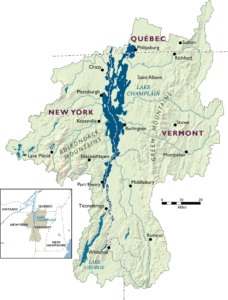
The Lake Champlain Basin Program (LCBP) coordinates and funds efforts that benefit the Lake Champlain Basin’s water quality, fisheries, wetlands, wildlife, recreation, and cultural resources. The program works in partnership with federal agencies; state and provincial agencies from New York, Vermont, and Québec; local communities; businesses; and citizen groups. These partners lead collaborative actions to address water quality and environmental challenges that cross political boundaries in a multinational watershed.
The LCBP was created by the Lake Champlain Special Designation Act of 1990, which named Lake Champlain as a resource of national significance. The LCBP was charged with developing and implementing a comprehensive and coordinated plan for protecting the Lake Champlain Basin. The LCBP works closely with program partners to implement management goals outlined in Opportunities for Action: An Evolving Plan for the Future of the Lake Champlain Basin.
The Lake Champlain Steering Committee guides the LCBP’s work. Its members include staff from the U.S. Environmental Protection Agency and several other U.S. federal agencies, state and provincial governments in Vermont, New York, and Québec; local governments; and Lake Champlain Sea Grant. The chairpersons of the LCBP’s Technical Advisory Committee, Heritage Area Program Advisory Committee, Education and Outreach Advisory Committee, and Citizen Advisory Committees also serve on the Steering Committee.
The LCBP receives funding from the U.S. Environmental Protection Agency, the Great Lakes Fishery Commission, and the U.S. National Park Service. The New England Interstate Water Pollution Control Commission (NEIWPCC) manages the LCBP’s financial, contractual, and human resources business operations on behalf of the Lake Champlain Steering Committee. LCBP staff are employees of NEIWPCC.
Visit lcbp.org to learn more.

